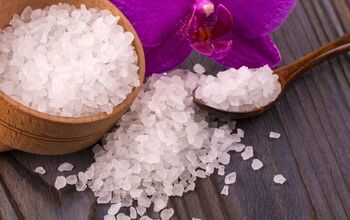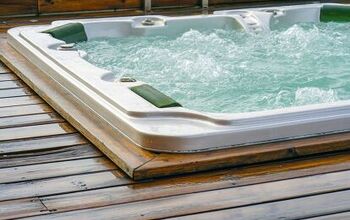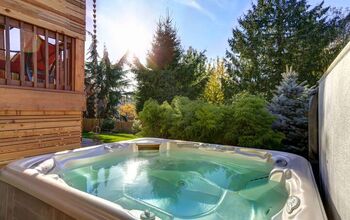Can Pavers Support A Hot Tub? (Find Out Now!)

After you’ve bought a brand-new hot tub for your backyard space, your next most important decision is to decide where you’re going to put it. Not only must the location be sturdy enough to support the hot tub, but you also want to ensure that it looks appealing and complements your landscaping to create a tranquil, outdoor sanctuary.
In determining the proper placement for your hot tub, you must understand how heavy a hot tub is when it’s filled with water. A standard two- or three-person hot tub usually weighs around 3,000 pounds when full, while a six-person model could weigh as much as 6,000 pounds. In addition to having a stable base for the hot tub, you also want one that is completely level to prevent unnecessary damage to the shell.
Oftentimes, a six-inch-thick concrete slab is ideal. But, what about pavers? Can pavers support a hot tub? Pavers are not only an appealing option that make it easy to find a style that matches your décor, they can also be used as the base of a hot tub. However, for best results, you want to choose pavers that are smooth and can be interlocked to yield a solid, flat surface.
Continue reading to find out more about how you can use patio pavers to support your hot tub and some best practices.
Do You a Need Pool, Spa, or Hot Tub Contractor?
Get free, zero-commitment quotes from pro contractors near you.

Supporting a Hot Tub with Pavers
Pavers are an excellent choice for supporting a hot tub, however, there are some precautions that must be properly addressed. Some pavers are raised in height, which can influence how flat the base is and may cause issues at the base and frame, placing stress on the tub’s shell. TO avoid any of these possible problems, opt for pavers that are smooth and have the ability to interlock and create a flat, level surface.
If you don’t plan to install a concrete slab under the pavers, a layer of gravel or sand must be applied to adequately support the weight of the hot tub. It’s highly recommended that you seek the help of an experienced contractor or structural engineer to ensure that the tub is properly balanced. If you go the DIY route with planning and execution, you risk harming the hot tub’s structural integrity. Once the sand or gravel is laid and the pavers are set, more sand or gravel must be added swept into the joints between the pavers to lock them in place.
If you’re absolutely set on a particular type of paver that is uneven, they can still be implemented. However, instead of using the pavers as the base of the hot tub, you can place the tub on a level concrete slab and surround it with the pavers to create the desired look. This is a great way to still get the look you’re going, while ensuring that the weight of the hot tub is properly supported.
Types of Pavers
Many people enjoy using pavers because there is such a wide variety of options available, which makes it easy to achieve a particular look or match your home décor style. That said, here are some of the most popular types of pavers that are commonly used for driveways, walkways, garden pathways, pool decks, landscaping, and other applications around the home.
- Clay or Brick Pavers: Made of clay and shale, brick pavers are often referred to as clay pavers. The colors that they come in are derived from the clay and shale materials, giving them a very natural, long-lasting hue. Brick pavers are a popular choice, as they are durable and offer a classic, smooth look.
- Stone Pavers: Stone pavers are typically mined or gathered from a quarry or rock outcrop, then cut and assembled to be sold as a paver. There are many different types of natural stone pavers out there, including granite, sandstone, slate, bluestone, flagstone, limestone, marble, and more. Each stone has its own distinct characteristics, making some more ideal than others for specific applications. For example, granite pavers are incredibly strong and can hold a ton of weight, while marble cannot.
- Concrete Pavers: Made from a combination of cement, aggregates, sand, dyes, and pigments, concrete pavers can vary slightly in terms of the manufacturing process. In most cases, minimal water is used and the mixture is applied to a paver mold to be squeezed and vibrated simultaneously. This results in a solid final product that is ideal for road usage. As such, concrete pavers are incredibly versatile, durable, and weather-resistant.
- Porcelain Pavers: Porcelain is a clay-based material that has been heated at extremely high temperatures. These pavers are non-porous and can be used for both indoor and outdoor applications. However, since they are less absorbent than other alternatives, they are often used most in wet locations like around pools.
- Cobblestone: Cobblestone pavers are typically made with granite, but may also be constructed from basalt, sandstone, or limestone. This style is very durable and has been around for decades, offering longevity and an appealing old-world look.
- Rubber Pavers: Modern day innovation has led to the creation of more realistic and functional materials, like rubber pavers. Usually made from recycled materials, rubber pavers are eco-friendly, sturdy, resistant to tearing, and cost-effective. Not to mention, they are also virtually maintenance-free and can be a great choice for hot tubs as they provide a non-slip surface.
- Plastic Pavers: Plastic pavers may be manufactured or, like rubber pavers, made from recycled materials. The plastic is melted with water and then combined with soil, poured into a mold, and left to dry.
Why Use Pavers as a Hot Tub Base?
While there are other alternatives to using pavers for a hot tub base, nothing else quite matches up. Although a concrete slab or poured concrete platform will support the hot tub’s weight, issues can arise over time – particularly from standing water the collects under the tub. Additionally, if mortar is used to hold the slabs together, it will disintegrate eventually and make the base unstable.
With this in mind, here are some of the many reasons why patio pavers can make an excellent base for your hot tub:
- They provide easy access. If an issue arises regarding the buried lines that lead to your hot tub, such as plumbing or electrical, pavers are easy to remove to allow quick access.
- They are incredibly durable. Pavers are a high-density product that delivers more support than concrete slabs or even wood decking. With concrete pavers, the low absorption rate makes them resistant to salt scaling and effluence which is a common issue with poured concrete.
- They are modular. With pavers, you can choose from a number of different patterns to create a unique look – from straight lines and curves to elaborate designs.
- They are economical. Overall, pavers tend to be a more affordable alternative to many other types of pavement out there, especially when you consider long-term. When you factor in maintenance costs and costs of replacement, pavers are much more economical than their wood or cement counterparts. They offer the appealing, organic look of natural stone at a much more cost-effective price.
Do You a Need Pool, Spa, or Hot Tub Contractor?
Get free, zero-commitment quotes from pro contractors near you.

Although pavers are an effective base for a hot tub, it’s still highly advisable that you work with a professional. They will need to consider factors such as load requirements, soil conditions, drainage, and paver style and thickness to ensure that you achieve the best results out of your pavers.
Related Guides

Jessica considers herself a home improvement and design enthusiast. She grew up surrounded by constant home improvement projects and owes most of what she knows to helping her dad renovate her childhood home. Being a Los Angeles resident, Jessica spends a lot of her time looking for her next DIY project and sharing her love for home design.
More by Jessica Stone

















![Cost To Drill A Well [Pricing Per Foot & Cost By State]](https://cdn-fastly.upgradedhome.com/media/2023/07/31/9074980/cost-to-drill-a-well-pricing-per-foot-cost-by-state.jpg?size=350x220)









